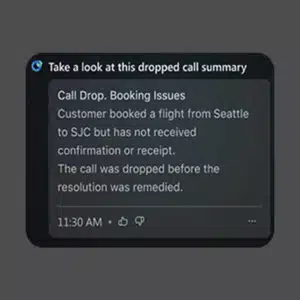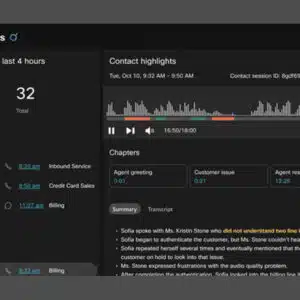


It’s difficult to measure the true value of customer experience (CX), but many have tried. According to research by McKinsey, growth strategies that increase customer satisfaction by at least 20% also lead to a 15-25% increase in cross-sell rates, a 5-10% boost to a company’s share of wallet (SOW), and a 20-30% increase in customer engagement. This means that providing a positive CX can significantly benefit a business.
Fortunately, delivering a seamless experience across any channel is possible with the right technology. To do that, staying up-to-date with the latest developments in the industry is essential. In this article, we’ll explore the biggest contact center technology trends to look out for in 2025 and how to leverage a single contact center solution.
10 contact center technology trends to look out for
1. Artificial intelligence (AI)
From generative AI to conversational AI, artificial intelligence is undoubtedly the talk of the town these days. Enterprises of all shapes and sizes are implementing AI technology across numerous lines of business—and now, it’s the contact center’s time to shine.
According to Gartner, many organizations are challenged by staff shortages and rising labor expenses. Per their estimates, agents represent up to 95% of contact center costs. Fortunately, by 2026, conversational AI deployments will reduce agent labor costs by $80 billion.
By then, Gartner expects 1 in 10 customer interactions to be automated. How? Two ways:
- Chatbots: Consumers who prefer self-service options can use live chat features, usually integrated into a brand’s customer support page, to engage with conversational AI chatbots. This bot can handle routine inquiries and route customers to the appropriate resources.
- Interactive Voice Response (IVR): When someone calls into a customer support center, they might first encounter an Interactive Voice Response system. Like a chatbot, IVR automatically answers customer questions and can route their phone call to the most appropriate agent and department.
These options are known as “virtual agents.” Using AI technology, they boost agent productivity by streamlining mundane or repetitive tasks. This not only means human agents are free to focus on more complex customer needs, but it also increases call containment and cost savings. Plus, self-service options provide a better customer experience by supporting first-contact resolution.
However, live chat and IVR won’t be able to handle all inquiries. If the customer issue is too complex, they can instantly elevate the interaction to a human agent.
Predictive dialer
Artificial intelligence isn’t just making waves when it comes to inbound communication. An outbound contact center can significantly optimize sales calls, market research, and lead generation thanks to predictive dialing.
Manually sifting through contact lists is tedious work. Even worse, it’s prone to human error. Predictive dialing eliminates these risks by automatically queuing and placing calls on the agent’s behalf.
Here’s how it works: Sophisticated AI algorithms anticipate the end of one phone call and proactively dial the next number in the queue. The result? Sales reps stay busy, with minimal downtime between engagements.
Predictive AI technology can also streamline the callback process. Let’s say someone calls in but doesn’t immediately connect to an agent. If the wait is long, they can schedule a callback at a later time. Normally, this would require an agent to manually find the time in their day to sit down and return the call. But, with predictive AI, the solution will monitor staff availability in real-time and automatically dial the customer when an agent is free.
Bottom line: Artificial intelligence isn’t just a boost to agent performance. It’s also a convenient, value-added improvement to the customer experience.
2. Continued cloud migration
According to Future Market Insights, the cloud-based contact center market was valued at $23 billion in 2022. But, by 2032, it will be over five times the size—clocking in at $120 billion. You can expect more enterprises to transition away from legacy systems to cloud contact center technology.
Why? For starters, hybrid work is now a permanent fixture of the business environment—not a temporary trend. Organizations are furthering support for their distributed workforce by investing in scalable services and at-home infrastructure. Rather than being limited by on-premise systems, advanced call center technology relies heavily on the flexible benefits of cloud communication.
Scalability
Consider how easy it is to scale operations quickly and seamlessly without the need for physical hardware. Traditionally, organizations had no choice but to install appliances and Private Branch Exchange (PBX) systems. Not only were these expensive to buy and maintain, but they were also only accessible on location. Plus, you couldn’t easily add new lines or make upgrades over time.
Fortunately, with a cloud contact center, you can onboard as many agents as you like in minutes. More importantly, all key features and capabilities are available in the cloud, meaning agents can access them from anywhere and on any device. With a larger talent pool at your fingertips, you don’t have to worry so much about staffing shortages when agents come and go.
Reliability
Sudden spikes and seasonal peaks can cause significant disruptions if your contact center technology can’t handle high volumes. Even an hour of downtime can be expensive, so prioritizing reliable infrastructure is always better.
Compared to on-premise systems, cloud contact center software is much more resilient. Providers normally host them across multiple data centers in various regions. This redundancy ensures that traffic is automatically rerouted to another if one location experiences an outage.
Additionally, cloud-based contact center solutions automatically apply updates in real time. These updates patch known vulnerabilities and roll out the latest features and performance enhancements to keep the platform running at its best.
The sudden shift to remote work in 2020 will continue well beyond 2025. Organizations are furthering support for their hybrid workforce by investing in distributed operations and at-home infrastructure. Rather than being limited by on-premise systems, contact center technology relies heavily on the flexible benefits of cloud communication.
3. Speech analytics and sentiment analysis
What if agents could understand exactly how a customer feels in real-time, live on the phone? They actually can with the combined power of speech analytics and sentiment analysis.
Technically speaking, sentiment analysis is another case of contact center AI. Yet, given its vast implications for agent performance and quality assurance, this trend stands all on its own.
Sentiment analysis evaluates a customer interaction to determine attitudes, emotions, and opinions about the conversation. It uses natural language processing (NLP) to gauge an individual’s tone and grade it as either positive, neutral, or negative. This information can help agents understand exactly how the caller is feeling and whether they’re addressing their concerns effectively.
Moreover, contact center managers can use this technology alongside automated call transcriptions to assess agent performance. For example, supervisors can compare a live transcript of an ongoing conversation with real-time speech analytics. This allows them to improve script compliance and pinpoint particular words or phrases that may lead to frustration.
Best of all, these valuable insights are great for workforce optimization. Contact center managers can share feedback with staff, identify areas of improvement, and coach them to provide a better customer experience in the future. More than just quality assurance, sentiment analysis offers a way to inspire employees and maximize agent productivity.
4. Automatic queuing and routing
According to statistics shared by CX Today, speed is the number one driver of customer satisfaction. Unfortunately, waiting is bound to happen when call volumes exceed agent capacity.
Times like these are when it pays to have an effective queuing system. Call queues don’t merely organize inbound calls, but they also manage customer expectations. Better yet, with advanced contact center technology, they even help salvage the customer experience.
For example, some contact center solutions use predictive analytics to estimate wait times. Then, using IVR, they announce how long consumers should expect the delay to last. Queues can also inform callers of their place in line—that way, they know they’re steadily advancing to the front. And if they don’t feel like sitting on hold, they can schedule an automatic callback. Altogether, these features discourage abandonment and help keep customers happy.
Of course, queuing and call routing go hand in hand. That’s why many contact center managers deploy an automatic call distributor (ACD) system, which routes cases automatically rather than agents manually opening them. The result? Faster connections and faster resolutions.
There are also various call routing strategies to choose from. For example, ACDs commonly provide skills-based routing. This strategy automatically distributes customer inquiries to agents with the appropriate skill set to handle them effectively.
Imagine someone calling looking for technical support. Their device isn’t working properly, and they need to talk to someone who can troubleshoot the problem. Rather than randomly distributing the call to any agent, skills-based routing sends it to one with technical expertise.
Intelligent routing isn’t just more efficient; it improves customer satisfaction by reducing handle times, minimizing transfers, and answering questions when making the first contact.
5. Personalization
Personalization is one of the most powerful of all contact center trends. In fact, it can have enormous business impacts.
According to McKinsey, companies that grow faster drive 40% more revenue from personalization than their slower-growing counterparts. Critically, personalized experiences aren’t just a fad—they’re what 71% of consumers now expect. More importantly, three-quarters of people grow frustrated when brands fail to deliver a tailored customer experience.
The good news is that today’s contact center technology makes it easy. With a comprehensive and highly compatible solution, you can democratize customer data at scale by breaking down silos between disjointed point solutions. For instance, customer relationship management (CRM) software is a must-have integration that allows valuable insight to flow frictionlessly to your team.
Rich profiles, curated and delivered by AI, empower agents to customize every interaction at a granular level. Using complete customer histories and contextual information, agents can offer individualized support that is 100% personalized to customer needs.
6. Omnichannel communication
Another crucial trend in the contact center industry is the continued rise of omnichannel communication. Customers are increasingly reaching out to brands on multiple platforms, whether through social media or over a phone call.
But how can you possibly be everywhere and anywhere all at once?
The answer is simple: omnichannel contact center software. Unlike traditional call center solutions, which only offer telephony-based customer support, this modern evolution serves all communication channels. It works by integrating them all into one comprehensive hub from which agents can easily switch between one or another depending on the case.
Nowadays, the average consumer uses up to five different channels to resolve one request. Moreover, 86% of them expect their conversations to flow seamlessly from one platform to the next. Fortunately, omnichannel solutions allow agents to retain information from past customer interactions.
As an example, let’s say someone begins their journey on social media. They reach out with questions about billing, but they don’t find any answers, so give your customer support team a ring. In this case, rather than asking the customer to repeat themselves, the agent can view the entire conversation and expedite the process. Plus, using purchase histories, customer behavior data, and other valuable insights, they can further personalize the experience.
7. Analytics and reporting
Website analytics, interaction reports, call data, and other information types are fueling tomorrow’s contact centers. With the right technology, organizations can seamlessly integrate their contact center solution into a customer relationship management system, breaking down silos and helping agents activate customer data.
Agent performance metrics—such as average response time or time-to-resolution—can help managers understand customer satisfaction and enhance workforce optimization. Funneling these insights into training and coaching programs enables continuous improvement, ultimately contributing to a better customer experience.
Ideally, managers should be able to view real-time and historical data from a single pane of glass. Centralized dashboards equipped with predictive analytics can help them appropriately forecast call volumes and route inbound cases. Likewise, these metrics are great for agent scheduling and distribution, ensuring teams are efficiently staffed.
8. Security
The global average cost of a data breach is $4.45 million per incident. In the United States, that number has more than doubled to $9.48 million.
But poor data security isn’t just a financial risk. It can also drive away customers. 75% of consumers would sever ties with a brand in the aftermath of a cybersecurity incident. So, more organizations are looking for solutions that prioritize privacy and compliance.
Ideally, contact center platforms will offer built-in security features, like data loss prevention. This automatically protects sensitive information, notifying you if anyone attempts to share or show it to external parties. Likewise, modern solutions should encrypt communications to prevent bad actors from accessing confidential data.
Other essential data security capabilities include:
- Secure storage for data at rest
- User verification, including risk-based adaptive authentication
- User provisioning and lifecycle management
- Remote wipe for distributed assets
9. Video conferencing
The use of video chat for customer support has skyrocketed in recent years. Remote conferencing has become a staple of daily life, and customer behavior has shifted to match.
As a byproduct, video conferencing software has emerged as a must-have for agents, especially with more consumers reaching out through mobile devices. Seamlessly elevating a live chat conversation into a high-quality video experience can help agents resolve inquiries faster and with a greater personal connection.
Video introduces a new dimension to customer support, allowing visual communication to steer the conversation naturally. Moreover, agents can more effectively collaborate on complex cases with screen-sharing and whiteboard capabilities.
10. Cloud calling
Telephony may seem like a basic capability, but it’s not to be overlooked. Although omnichannel communication is on the rise, calls are still a preferred channel for many. Fortunately, cloud calling—enabled by Voice over Internet Protocol (VoIP)—allows organizations to invest in digital infrastructure without sacrificing voice.
Cloud-based telephony systems require only an internet connection. That means no landlines, PBX systems, or cables are required. Agents can make or receive calls on virtually any web-enabled device, whether a computer, softphone, or even their smartphone.
Cutting-edge solutions also leverage artificial intelligence for noise cancellation. In other words, they automatically reduce background noise and manage jitter to provide a high-quality calling experience.
Supercharge CX with Webex Contact Center
Luckily, you don’t have to search high and low for a solution that can help you capitalize on the latest contact center technology trends. With Webex Contact Center, you can harness the power of AI, customer data, workforce optimization, and more.
As part of the Webex Suite, our platform is jam-packed with all the essential tools you need to innovate the ideal experience. Anticipate customer needs, empower your agents, and streamline operations with an omnichannel cloud-based solution.
Use proactive digital messaging for outbound engagement and AI-powered virtual agents for convenient self-service. With decades of experience in the contact center industry, you can trust us to deliver the only CX platform you’ll need to succeed.
Learn more about how Webex Contact Center can deliver business results.
Source link





No Comment! Be the first one.